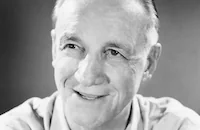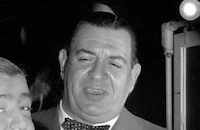Lupe Velez, then Weissmuller's wife, plays Schnarzan's troublesome ex-girlfriend, kidding Maureen O'Sullivan's "Jane" by showing up at the party in an ultra-revealing costume. (O'Sullivan was notorious at the time for her brief attire in the Tarzan series.) Robert Young pops in as himself. Laurel and Hardy's appearance involves an egg-breaking sequence performed with Lupe that is considered a classic. Also contributing to the fun are an unbilled bit by the Three Stooges as autograph seekers and a Technicolor cartoon spoof from Walt Disney, introduced by Mickey Mouse, titled The Hot Chocolate Soldiers. Despite it's Disney credentials, the latter cartoon is a wild animated fantasy full of the most over-the-top phallic imagery from gingerbread men ramming the walls of a candy castle with chocolate logs to exploding custard eclairs to an orgiastic climax where everything gets covered in hot melted chocolate. Yikes! How did this get past the censors?
Although only 70 minutes long, Hollywood Party also includes eight musical numbers. Among them are the title tune written by Richard Rodgers and Lorenz Hart and performed at the film's opening by Frances Williams and a chorus of scantily clad telephone operators; "Hello," another Rodgers and Hart tune performed by Durante and Pearl with the chorus; and Durante's signature "Inka Dinka Doo."
Originally planned as an all-star musical to be called The Hollywood Revue of 1933, Hollywood Party went through seven writers (five un-credited) and five directors (none credited) as it was refashioned into a vehicle for Durante. The final director, silent-screen pioneer Alan Dwan, considered the film's goofy plot and disparate elements "a nightmare" and was inspired to use a trick ending. In a gimmick famously repeated many years later on TV's Dallas, Durante is awakened (by his real-life wife) to realize he has dreamed the whole outrageous thing!
Producers: Howard Dietz, Harry Rapf
Director: Richard Boleslawski, Allan Dwan, Edmund Goulding, Russell Mack, Charles Reisner, George Stevens, Sam Wood (all uncredited)
Screenplay: Howard Dietz, Arthur Kober
Art Direction: Fredric Hope
Cinematography: James Wong Howe
Costume Design: Adrian
Editing: George Boemler
Original Music: Richard Rodgers/Lorenz Hart, Nacio Herb Brown, Walter Donaldson, William Axt (incidental music, uncredited)
Principal Cast: Jimmy Durante (Schnarzan), Lupe Velez (Herself/Jaguar Woman), Jack Pearl (Baron Munchausen), Charles Butterworth (Harvey Clemp), Polly Moran (Henrietta Clemp), Eddie Quillan (Bob), Stan Laurel (Himself), Oliver Hardy (Himself).
BW-69m.
By Roger Fristoe



































